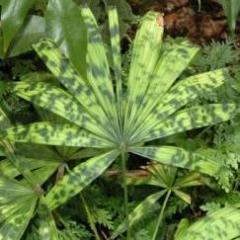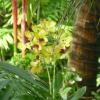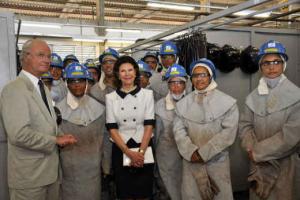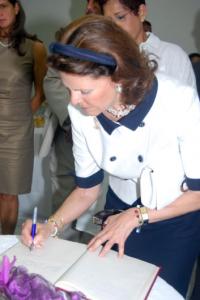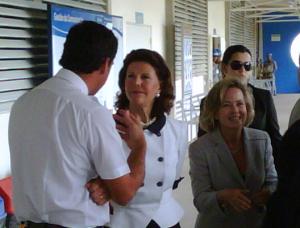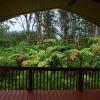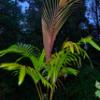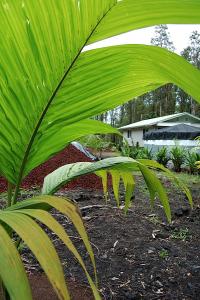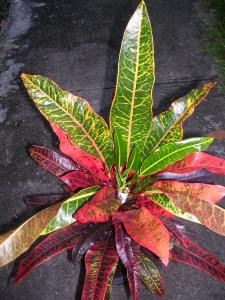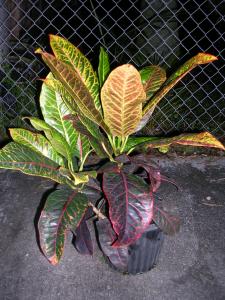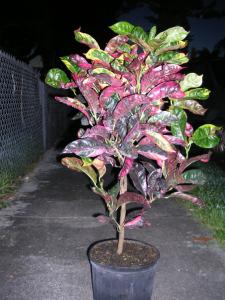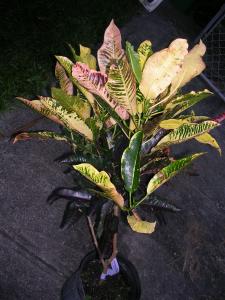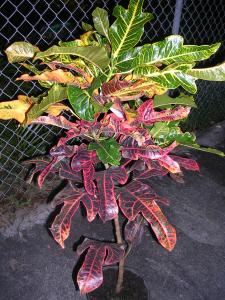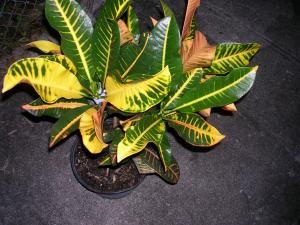Leaderboard
Popular Content
Showing content with the highest reputation on 03/23/2010 in all areas
-
1 point
-
- Saturday, 8:22AM: This was the fourth time the South Florida Palm Society has held their spring sale at Montgomery Botanical Center, and it seems to get better every year. These are the usual 'photocopy' of the booth I do after we finish setting up on Saturday morning. A record of what was brought and where it was placed. - Licuala peltata var. sumawongii grouping on the left, with a Heterospathe phillipsii in the center, and a group of 3 gallon Carpoxylon macrospermum on the far right. - The left edge corner of the booth went to the Kerriodoxa elegans gathering, with Dypsis canaliculata in the middle, followed by Red Sealing Wax Palms, Cyrtostachys renda, on the right. - The path that draws people into the booth and gets them hooked on the tables. That 10 gallon palm on the edge to the right is a Dypsis heteromorpha. Ryan1 point
-
Howdyall: A while back, I bared my 'puter travails, and got some good, sage advice, and a new computer back last September, with about 800 GB of memory, about 400 times the memory of my old 'puter. Whoa. 800-expetive times. Yike. So, it came with Windows 7, and well, it's been a few months. For sure, Windows 7 smokes smokily and moves so fast I gag sometimes. On the other hand, sometimes it fails to start, leaving the black screen, and forcing a reboot. And, it won't take my printers well. It airily refuses to acknowledge the existence of the trusty Brother 1440. And, it eats my pictures! (Saves them to a directory I can't find,which I know I can do something about but it's the principle of the thing . . . .) I will, at some point, partition the hard drive and install Linux, report to follow. One thing that is good, is that I haven't had to buy any new programs, which I'm really giving the arm to our 'puter lady at the office about. (Our office system! Slower than molasses in June in the Southern Hemisphere, and Congress, Parliament and the respective Diets in a series of dithers). Now that I'm the webmaster of the PSSC, that extra speed helps. (Dude! That horse cart ain't makin' it on the 101 . . .. )1 point
-
A neighbour called me a while ago and said that Sirinhaém had an important visit this afternoon: King Carl Gustav and Queen Silvia of Sweden stopped for a brief visit to the beach on their way to the neighboring municipalty of Ipojuca where they've visited a shipbuilding factory recently innaugurated. The Royal couple is staying at a nice beach resort in Muro Alto, 30 km to the south of our house and not very far from the hotel where Alberto stayed with his family last year. The newspaper reports that they both love drinking coconut water and appreciate very much the local plants, especially the palms (they must be relatives of Bo and Ciczi...haha). Queen Silvia (who is half Brazilian and lived her childhood in São Paulo) is a fantastic person indeed and she often comes to Recife on short vacations. My cousin Sérgio Lôbo is the commercial consulate of Sweden for the Northeast and he represents some companies like Volvo in our market, so he is often in touch with them during these visits. They're quite simple people and very interested in Nature and Environmental issues. From here they're going to the heart of Amazonia in São Gabriel da Cachoeira where they'll stay for the next weekend. I'm disappointed for not being in the other house this afternoon when they arrived at the beach...otherwise I would try to give them a couple of local palm seedlings for their glasshouse garden in Stockholm...and also send another one as a surprise souvenir for Ciczi...1 point
-
- 7:50PM: That was one fine dinner, indeed. Thanks go out to Mike again for a great spread and for putting up with us crazy palm people. Towards the end of dinner, Jeff said "Hmm, let's call Matty and see what he is up to." With a few rings, Matty answered his phone and a coherent conversation almost took place. I think Matty was working in his yard on something, as Jeff bothered him with questions while Andrea held the phone. A few minutes later they called him again... - 8:12PM: It was the end of the evening and everyone was saying their goodbyes to Bill as he was flying home tomorrow afternoon. The tour at Mike's was a great way to put a conclusion to the Extravaganza weekend. Bill kept Jeff upright as he and Ron discussed a carry-over conversation from earlier. - 8:13PM: Everyone was leaving, so we had a few seconds for last minute photographs. I had to get a shot of Bill and Ron together before the evening ended... - ...and again with the Ranch Hand... Ryan --<1 point
-
- 7:23PM: "Dinner's ready." With a few more turns of the meat and the inevitable flair up, dinner was ready to serve. The chicken and pork were very hot and went straight from the grill to the table. - To quote Anthony Bourdain, there's nothing like good food porn. The pork was well cooked and didn't need any sauce to go with it and was fantastic. One piece got a bit close to the flame and brought the fire with it to the table. Jeff saw the ignited pork and thought "I got this..." so he stood up, moved right in front of Bill, and extinguished it with his two fingers. [sizzle]... He forgot that fire meant hot... - 7:24PM: ... "AHH... Thanks for alcohol! ... thanks for alcohol!" Jeff exclaimed while running in place and waving his burnt fingers in the air before dunking them in his drink... - 7:25PM: Mike made it clear to everyone that the food was very hot, someone didn't get that message. Ryan1 point
-
I use the palm/cactus mix and add extra perlite for drainage. Tossing in a handful of used coffee grounds or tea leaves would give a boost.1 point
-
Palm snobs? I don't know why anyone wouldn't want a royal in Fl. They are native, self cleaning, really pretty, more cold tolerant than foxtails, hurricane resistant (though not so much as Sabal palmetto), and a way better choice than a queen if the climate is good. Of course, you've got people who also hate Sabal palmetto, which is a pretty palm if LEFT ALONE. When trimmed they are really ugly and terrible, but when untrimmed they are quite pretty. The dead leaves trimmed with orchids and bromeliads on the boots is something to behold in my opinion. Yep, the Royals are not seeding yet. I got two infructesences emerging but not opened yet on my only flowering one. The other is barren so far, 15 years after planting as 5 footers.1 point
-
Thats OK. There are some great photos by Ryan here that definitely were worth revisiting! Ron.1 point
-
Hi Meg, after seeing your home and garden it kills me to hear of your damage. Thank God you were able to save your lipsticks! Good luck, Peter1 point
-
1 point
-
1 point
-
1 point
-
here Root Down - you are truly a sick palm person. Therefore, you have found the proper home here on PalmTalk, we are all pretty sick about palms on this forum! Welcome from another zone pusher! Kindest regards, Ron.1 point
-
Gileno, Fascinating! Thanks a lot for the update, had no idea! But then again, I don't really make it my business to keep up with these things! Would have been a nice touch if they could have just waited a few weeks and joined us in Rio next month for the Biennial! Bo-Göran1 point
-
The Calyptrocalyx elegans will grow to about 8 ft. in height, while tolerating full sun, a rare and perfect choice for this particular use. The emergent red leaf will enhance our enjoyment of the plantings. Here they are, all in a low berm: Turns out, 18 little palms is all we can manage for the day. Phew! Time for a mai tai. A look at some of the native ohi'a trees on the property... Through a vivid green Clinostigma...1 point
-
So at the second warning or 66% warn status - would that classification be termed a "stumpy" ?1 point
-
1 point
-
1 point
-
1 point
-
1 point
-
1 point
-
1 point
-
1 point
-
1 point
-
1 point
-
1 point
-
1 point
-
1 point
-
1 point
-
1 point
-
1 point
-
1 point
-
1 point
-
1 point
-
Andy - I use Palm Special #7216 12-04-12 from AFEC, Atlantic Fertilizer & Chemical Company 18375 S.W. 260th Street Homestead, FL 33090-1488 You are in North Palm Beach. Try to Private Message pdleft. Her name is Betty and is the President of the Palm Beach Palm & Cycad Society. She is a friend and can recommend where to get a palm special fertilizer that is closer to you. You could also network with members up there that are familar with your growing conditions and can give you valuable tips. There are some great growers and Palm Beach Palm & Cycad Society members that are friends and will be very helpful to you. Best regards, Ron. <H3 style="FONT-SIZE: 20px"> </H3>1 point
-
The thought of that happening comes to mind more often than I would like. I carry a back-up battery setup just in case, no pun intended. Ryan1 point
-
- As the cart pushed on to the next area, I took a parting shot of the nearest Attalea crassispatha. It is an elegant species for sure, and a very rare palm to boot. - We stopped for a short while in this particularly palm-dense area, and gazed upon a healthy mix of unique species. Here are the larger Sabal mauritiiformis I spoke of, with a robust individual in the center. It is a favorite among many fan palm enthusiasts. That persistent green color on the leaf bases is hard to ignore. Tucked in on the left side, is a lone Schippia concolor, and a Butia sp. just about makes it in on the far right side. - This tour was filled with firsts for this one palm nut. If one surprise wasn't enough, there was another one around the next corner. In behind the Sabal mauritiiformis, was a very interesting group of a newly described species of Syagrus. Featured in a 2004 issue of PALMS, Syagrus vermicularis has bizarre rachillae that look like freshly-made pasta noodles. There is a nice one in the center of the photo, with a few others in behind. Montgomery B. Center's own Dr. Larry Noblick discovered, described, and named this palm. Larry once mentioned, that in the wild, he could not find a palm with female flowers. Without this data, he could not finish the description of the species. He brought seeds back, germinated them, grew them up, and after nine years had mature plants. After all that, he then could finish his work on this freaky palm. - We left this species-rich area and headed towards Nell's House, the focal point of the center. This rather old and heavy-footed Ponytail Tree (Beaucarnea recurvata) poses for a quick shot as the cart moves on by. Ryan1 point
-
- For a brief moment, I jumped off the golf cart to take a few photos. I noticed the abundantly full infructescences on the Gingerbread Palms, Hyphaene thebaica so I took a closer look. The area was being shaded by the nearby Bismarck Palms. Hyphaene species are underused in the South Florida landscape, since they add color and are easy to grow. They are a tad slow when small, and can not grow in a swampy, wet environment, but otherwise make great palms. - With the Hyphaene in the background, I walked around the golf cart to take a photo of everyone including our canine visitors. It just so happened that of all the dogs and their companions going for a tour, got onto the same cart. Our guide, MBC executive director M. Patrick Griffith, is at the wheel. It was his idea to take this photo and it came out well. I just about got all four dogs to look at the camera. - I got back on board, and we were on our way again. We took a short way around one of the palm rich areas and came across this very interesting species. This is Syagrus cearensis from Brazil, and it has the peculiar habit of clumping or dividing equally into either two, three or four stems. It always does this, and has a remarkable rate of growth. The one stem on the left is just loaded with fruit. - We continued our way through, and as we were moving I nabbed this shot of a shaded area that had quite a few species. There is a Rhapis sp. in the center, with a Livistona sp. in the back, towards the left. Ryan1 point
-
- Directly to the left of the Serenoa repens, was this grouping of Gingerbread Palms, Hyphaene thebaica. I have always liked Hyphaene species, they have such interesting growing habits, and unique details. One of the plants on the right was in full fruit. - We moved off again, and made our way down this one grassy knoll bordered by palms, the "Palm Walk". Many of the photos I took were taken as the cart was moving. It made for some quick decisions and last-minute framing of the shot. I still managed to get some great photos. Including this one of a rather robust Phoenix sp., possibly a Phoenix canariensis. - Our cart comes to rest at another location, while another one passes by. This cart was the tour just ahead of ours and they were on their way back. Behind the cart is a batch of a large Sabal sp. - One of the highlights of the tour was definitely the viewing of this one, ultra-rare palm, Corypha taliera. This species of Corypha is extinct in the wild and is survived by only twelve plants left in the world. Eleven of these plants are at the Montgomery Botanical Center, with an additional one at the Indian Botanic Gardens in Bengal, India. There have been reports of an old specimen of a Corypha species growing at the Dhaka University campus in Bangladesh; that might be C. taliera. But this has yet to be confirmed. The conservation status of "Extinct in the wild" will stay unchanged. It is hard to think that the survival of this one species is solely based on these few plants' ability to flower, and then die. An interesting dilemma. I took this photo as we were driving off, as the other cart continued its way back. Ryan1 point
-
- At 11:39 AM, customers were continuing to pour in, enjoying the lack of an admittance fee and the thrill of seeing the center for the first time. The pace had slowed a bit by this point, but palm enthusiasts were still finding collectible species to add to their carts. Pushing a cart up the center aisle, vendor #99 Rick Johnson, had borrowed it to ferry some palms to the register tent. - A hub of activity surrounds the register tent, as customers pay for their plants, food tickets, or tours of the center. On returning from the tour, many customers spoke of how much they didn't know about the center. The size of the grounds, the palms in the collection, or even the history were some of the things that were new to many. - Speaking of the tour, I wanted to make sure I had my turn before the day was over. After buying my ticket, I made my way to the staging area by the food tent. I took a seat waiting for one of the large golf carts to return. Next to me was this very happy Weimaraner who was taking the tour as well. The golf cart I would eventually take, would become more canine influenced... but more on that later. - At 1:53 PM, my tour of the center began. I do not remember how many carts they had running in sequence, but I did not have to wait long for the next one. Those of us who took the same cart, were lucky to have the executive director of Montgomery B. Center, M. Patrick Griffith, as our tour guide. As you would imagine, he was immensely knowledgeable about everything involving the center. The first area of the center we came to was a large open area filled with an array of palm species. This first section had a healthy population of Saw Palmetto Palms, Serenoa repens. Ryan1 point
-
Saturday afternoon begins to wind down to a close, as customers begin to grab their last minute choices. This is the last group of photos from Saturday. At this point, almost halfway through the weekend, I call this sale a success. It had already passed the monetary requirements for two days, in the span of one. Many questions were raised towards where the fall sale will be, from all the parties involved. This created some interesting conversations for Saturday evening into Sunday morning. We will have to see what happens until then. - Plant valet Travis Searle moves a large Bottle Palm, Hyophorbe lagenicaulis, back towards the aisle where his cart lies in wait. Jeff Searle supervises the move. - After heaving the palm onto his cart, Travis follows the soon to be owner of the palm, Forum member Brad Evers (flskimmer) [red stripes] down the aisle. Brad talks with vendor #91 Jody Haynes [center-left, ponytail] about the palm he just got from him. Adding in on the conversation, is vendor Chuck Grieneisen (#13) [far-left]. Late Saturday afternoon is always a relaxed time at the sales. Many vendors take this time to shop some more in other vendors' booths. - It is now 4:11 PM, and the honor of being in the last photograph of Saturday goes to Forum member Dave Martin (Dave-Vero). He drove most of the day to get to the sale a bit late, but he still got what he came for. He is holding a 3 gallon Rhapis laosensis he had on his shopping list. We still had a few left in the booth. It was the second time seeing him in person, and Jeff and I were glad he came to the sale. Including Dave, I had an unofficial count of Forum members numbering about 13 or so who were at the sale this day. Ryan1 point
-
Hey Brad, welcome to the Forum and glad all your palms made the trip back in great shape. They look very well for such a long trip. It was a pleasure to have met you, and hope to see you at future events. Ryan1 point
-
- For a moment or so, I lent my camera to Dominique Shim, grand-daughter of Dave Romney, who took a photo of myself in front of the booth. I did my best to smile with the sun in my eyes, and with people making faces at me. - After gathering part of her stash, SFPS Board member and editor Sandra Farwell makes her way out of the booth and towards the registers. I had to run past her to catch this photo of her, over-loaded with rare palms. She had a great selection of species with her, from left to right: Pelagodoxa henryana, a 3 gallon Astrocaryum alatum, and a small Orania ravaka. - Checking on the sale, and how the transporters were doing, SFPS President and Forum member Bill Olsen (Bill Olsen) sits down for a brief second. He asks how the tips had been with Dominique Shim and Fiona Romney. When I was younger I did the same thing with a wheelbarrow, which I still have. I spent many of sales carting out plants, and it was fun. - Some time after lunch, I remembered I saw another variegated palm I had forgot to photograph. Around 1:26 PM, I trotted over to Chuck Grieneisen's (#13) booth to look for it. It is a well variegated Paurotis Palm, Acoelorrhaphe wrightii. We can only imagine what it will look like as it gets older. Ryan1 point
-
- 11:13 AM, and at that time the sale is officially busy at this point. The sales area was being filled with the scent of BBQ, as the tent holding the food and drink churns to life. Stepping across from the booth, I noticed Forum member Tom Christian (tikitiki) discussing palms with vendor #33 Dave Romney. Tom absorbs quite a bit of knowledge from the revered grower. - I got an email mentioning from a forum member who wanted to see the award palms closer up. Here is a better view of the Licuala sp. 'Togu Budo'. The arrangment of the leaf segments is quite unique. It has four large segments, equally spaced with a fifth, thinner, trailing segment off to one side. Is there a species name for this Licuala yet? - The Dypsis onilahensis, shown slightly to one side. The bright white crownshafts attract a lot of attention. We needed a sign that said "Don't Touch". People didn't think the color was real, so they would reach up and rub it, taking some of the glaucous covering off. By the end of the day on Sunday, the crownshafts were almost green. - I was lucky to meet a pair of newer Forum members, who came to fill their vehicle with palms. Brad Evers (flskimmer) and his wife came with a printed copy of the sale booklet all checked and noted with species they were interested in. They took a few loads out before the day was done. Ryan1 point
-
- A spread of cream coloration for any fans of variegated palms. Staying in Ellis Brown's (#68) booth, I found this incredible example of variegation on a Majesty Palm, Ravenea rivularis. This is just one leaf, and most of it was showing great coloration. - A view of the entire palm, with the morning sun bouncing off of it. Cream colored leaflets were found on every leaf, and the rachis and petioles had brilliant stripes. The flagging tape ment it was entered in the show, but it did not win an award. It was given a surprisingly great price, so it did not last long into the morning. If it had lasted a little longer, with a second thought, I would have nabbed it myself. - I thought the coloration on the petioles needed a second look, so here is a zoomed view of the leaf bases. Some of those stripes are very broad. - Following the path around towards the exit, I noticed this variegated Lady Palm 'Kannonchiku' in the booth of Steve Stern (#35). It was an estabilished cultivar, named "Ayanishiki"which means "Figured Brocade". Ryan1 point
-
Before we knew it, it was again, the Saturday morning of a palm sale. After so many years, there is always anticipation. You go through your personal, check-listed copy of the sale list as you go through the booths. In addition, you are always on the lookout for the 'unadvertised special' as some of us like to call it. There was some minor odds and ends to do in the booth, then afterwards I went shopping for myself. We had about an hour or so until the sale opened, so I as I went shopping I photographed as well. - Starting to the booth next door to ours, I entered the selection belonging to vendor #68 Ellis Brown, a very good friend of mine from the old days. He recently returned to the palm sale 'circuit' after a hiatus of a few years. He had a great selection of oddities to choose from, and the first group to catch my eye were these unique palms. This is a group of Triangle / Teddy Bear Palm Hybrids (Dypsis decaryi X leptocheilos). - An added close-up of the crownshaft/leafbases of the hybrid. You can see influences from both the Triangle and Teddy Bear Palms. It is hard to see in the photo, but the leaf bases have a faint three-sided shape to them, in addition to the abundant tomentum. Ryan1 point
-
So thats where that spider went...hmm...lol Well I am glad you got home in one piece, with you and the Dypsis intact. Generators for lighting is a great idea, we should have done that this time. Another comment for the note page for the next sale... Ryan1 point
-
- The sun begins to go down at this point, and decided to do a little shopping of my own. Across the aisle held this great looking group of Copernicia ekmanii. - Two of the most noticable of palm people, collector Ray Gompf and vendor #33 Dave Romney. - For what was a good idea at the moment; vendor (#16) and Forum member Mike Harris (Caribbean Palms) tries to pound a wooden stake into the solid rock pathway of the original Old Cutler road. He didn't make much headway. - Artist and vendor #84 Linda Apriletti gets in some shopping time just as the evenings' festivities began. Ryan1 point
-
Yup, they sure are. Dug, moved and ready for someone's yard. Ryan1 point

